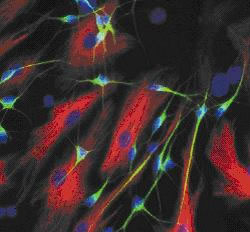Scientists have discovered that brain cells have an in-built electrical trip system to prevent themselves from becoming overloaded. Nerve cells respond to chemical signals called neurotransmitters, which lock onto specialised docking sites, called receptors, that are dotted across the cell surface.  The binding of a neurotransmitter to its receptor triggers pore-like channels in the cell membrane to open, allowing different chemicals to flow into and out of the cell, altering its activity. One very potent substance that behaves in this way is calcium, which in too large-a-dose could destroy the cell. But now, writing in the Journal of Cell Biology, Stanford researcher Fuminori Tsuruta and colleagues have found that nerve cells protect themselves from this kind of damage by effectively "tripping out".
The binding of a neurotransmitter to its receptor triggers pore-like channels in the cell membrane to open, allowing different chemicals to flow into and out of the cell, altering its activity. One very potent substance that behaves in this way is calcium, which in too large-a-dose could destroy the cell. But now, writing in the Journal of Cell Biology, Stanford researcher Fuminori Tsuruta and colleagues have found that nerve cells protect themselves from this kind of damage by effectively "tripping out".
The team have discovered that, rather like pulling players off a football field, when a neurone senses that it is becoming over-excited, a signal is issued that leads to the removal of the neurotransmitter receptors and the calcium channels from the cell surface. This is achieved by wrapping the receptors and channels up into oily bags called endosomes, inside the cell where another another chemical messager, called PIKfyve (short for phosphatidyl inositol (3,5) bisphosphate), causes them to be broken down. The process isn't fool-proof, however, and some diseases, including stroke and Alzheimer's, can nonetheless bypass these safeguards and lead to cell damage. That's why, say the scientists, the discovery of this new pathway opens up a host of fresh avenues for exploring ways to reduce the damage done to the brain by various diseases.
- Previous Painful to listen to
- Next Sneaky Sounds Enhance Eyesight










Comments
Add a comment